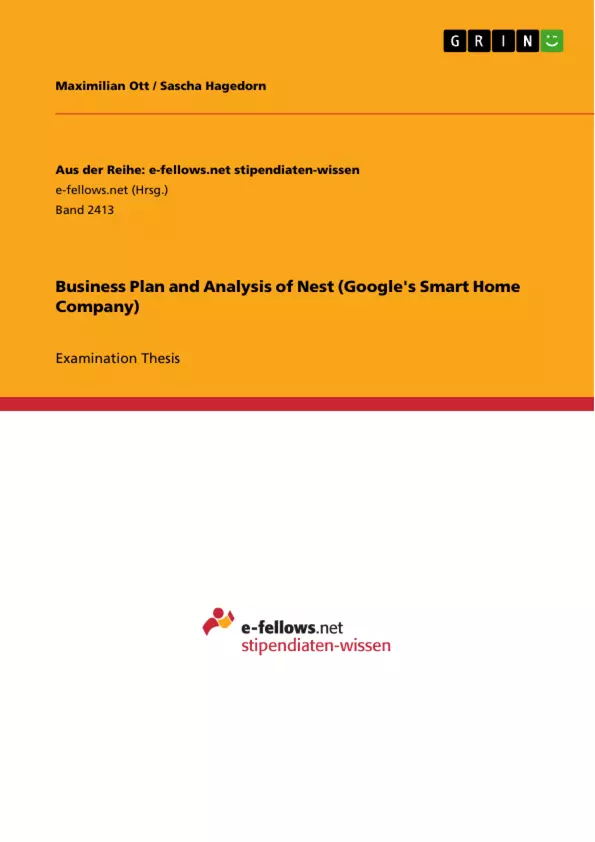An analysis of NestLabs Inc., Google's Smart Home company, and their current business situation is conducted. Internal and external influences are considered. A SWOT Analysis is done and leads in the end to a strategy proposal which NEST should follow in order to improve business in the future.
Inhaltsverzeichnis (Table of Contents)
- Introduction
- Nest Labs, Inc.
- Nest Labs's company culture and atmosphere
- Finances
- Outside forces.
- Political
- Economic
- Social
- Technological
- Industry analysis
- Porter's Five Forces / Industry Profitability.
- Bargaining power of buyers
- Nature and intensity of the rivalry amongst competitors
- Threat of new entrants
- Threat of substitute products or services.
- The bargaining power of suppliers
- Industry Structure Type.
- Industry Life Cycle
- Value Chain of Industry Structure
- Competitive analysis.
- Market Analysis
- Smart home market
- Kinds of Markets
- Marketing Analysis
- Segmentation
- The connected home market
- Hero Devices and Service Providers leading the way.
- Awareness Channels
- Customer Segmentation
- Leading attitudes and possible barriers
- Targeting.
- Positioning
- Brand awareness and service provider
- General market interest
- Strategic recommendations
- Analysis of Nest Labs's company culture and its evolution since Google's acquisition.
- Examination of the financial performance of Nest Labs, including revenue and growth prospects.
- Assessment of the impact of external forces like political, economic, social, and technological trends on the smart home industry.
- Exploration of the competitive landscape and industry analysis using Porter's Five Forces framework.
- Evaluation of market opportunities for Nest Labs in the growing connected home market.
- Introduction: This section introduces Nest Labs, Inc. and its mission to create smart homes that care for their occupants and the environment. It highlights the company's focus on programmable thermostats, smoke and carbon detectors, and their expansion into the connected home market through partnerships and product diversification.
- Nest Labs, Inc.: This chapter provides a detailed overview of Nest Labs's history, co-founders, and acquisition by Google. It delves into the company's culture and the challenges it has faced since being acquired, including management styles, employee morale, and product development delays.
- Nest Labs's company culture and atmosphere: This section explores the changes in Nest Labs's corporate culture after Google's acquisition, including potential impacts on employee morale, innovation, and decision-making processes.
- Finances: This chapter examines Nest Labs's financial performance, including its growth trajectory, budget allocations, and revenue generation since the acquisition. It also analyzes the impact of Google's resources on Nest Labs's acquisitions and strategic decisions.
- Outside forces: This section delves into the impact of global trends on the smart home industry, focusing on individual empowerment, diffusion of power, growing demands for food, water, and energy, and demographic changes. It highlights the importance of understanding external factors that can influence the industry's evolution.
- Political: This chapter explores the influence of government policies and regulations on the smart home industry, particularly in relation to sustainable development and energy efficiency initiatives. It examines the role of international agreements like the United Nations Climate Change Conference in driving the adoption of smart home technologies.
Zielsetzung und Themenschwerpunkte (Objectives and Key Themes)
This document outlines the business plan for Nest Labs, Inc., a home automation company acquired by Google in 2014. The plan analyzes the company's current situation, including its company culture, finances, and outside forces impacting the smart home industry. It also explores the industry landscape, the company's market position, and potential strategic recommendations for future growth.
Zusammenfassung der Kapitel (Chapter Summaries)
Schlüsselwörter (Keywords)
The central themes and concepts in this business plan revolve around the smart home market, Nest Labs's company culture and evolution after the Google acquisition, the impact of external forces on the industry, and the competitive landscape. Key terms include smart home automation, connected devices, Nest Labs, Google acquisition, corporate culture, financial performance, industry analysis, Porter's Five Forces, market segmentation, and strategic recommendations.
- Quote paper
- Maximilian Ott (Author), Sascha Hagedorn (Author), 2016, Business Plan and Analysis of Nest (Google's Smart Home Company), Munich, GRIN Verlag, https://www.grin.com/document/369380



